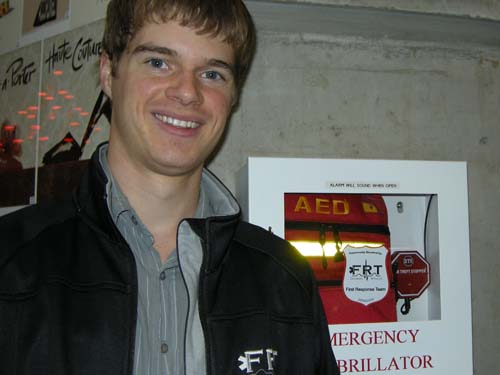
You’re walking through the University Centre on a quiet evening when the man walking ahead of you suddenly collapses and seems to be having a heart attack. Would you know what to do?
Philip Baker would. And he’s hoping to make it easier for any bystander to respond. As one of the co-ordinators of the University of Guelph First Response Team, this fourth-year student is one of several students providing first aid on campus.
Some cases are simple cuts and scrapes, but some are serious. “Of the 407 calls the First Response Team responded to last year, about 30 were potentially life-threatening,” Baker says.
A fast response is especially urgent when someone has a cardiac arrest. Every second counts; the more quickly the person can be treated, the better his or her chance of survival. But most bystanders feel they don’t know how to respond when they see someone apparently having a heart attack, or worry that they’ll do the wrong thing and make it worse.
That’s why the First Response Team has donated two public access defibrillators to the University. One has been set up in the University Centre, the other in the library. While the name may sound high-tech, Baker says they’re designed to be extremely easy to use. “When you push the ‘on’ button, the device tells you what to do, step-by-step,” he says.
The portable defibrillator is designed to analyze a person’s heart and determine if the heart would benefit from applying energy (a shock). Simple audio and visual prompts lead the volunteer through proper use of the device. If the person’s condition will not be improved by receiving a shock, the defibrillator will not allow the shock to be administered.
The decision to purchase the defibrillators started as a team effort with Baker and fellow co-ordinators Laura Jewell, whom he worked with last year, and Catriona White, who took on the role this year. The move was then approved by the First Response Team board and supervisors. “It was really a full team effort,” says Baker.
“The public access defibrillator is the best thing for cardiac arrest survival since the invention of CPR,” adds Baker. “CPR just helps to keep oxygen going to the brain until medical help can arrive, but the defibrillator can actually get the heart re-started.” And the built-in safety mechanisms mean it can’t harm anyone even if it is used unnecessarily.
Does having these defibrillators readily available really save lives? Baker cites a 2002 study from the New England Journal of Medicine. Defibrillators were installed in the Chicago airports in 1999, and during the two years of the study, 21 people had cardiac arrests in the airports. Four of these were not near defibrillators and were not treated; all four died. Three others died despite attempts to use the defibrillator, but the remaining 14 were successfully treated.
Baker adds that he feels it’s significant that six of the people who successfully used the defibrillators when they saw someone having a heart attack had no training or experience in using the machine. They just took it out of the box, listened to the instructions and made it work.
The First Response Team has four people on call from 5 p.m. to 8 a.m. each day and around the clock on weekends. During normal business hours, the University’s medically-trained fire prevention staff provide similar services. “We now have bicycles to help us get around campus quickly,” says Baker. “We can arrive sooner than an ambulance would and begin treatment immediately. We also help to determine whether an ambulance or further medical care is actually needed.”
The defibrillators in the UC and library may shave off a few more seconds before the team or ambulance arrives. That is, if a bystander steps up and uses one when needed. “It’s something you hope you won’t ever have to use,” adds Baker. “But you want to have it available just in case.”
In the case of any medical emergency, Baker says you should call Ext. 2000 on a campus phone. And for more information about the First Response Team, go to www.uoguelph.ca/frt.
Know How to Perform CPR
The First Response Team (FRT) will be holding their annual CPR day in January, but Baker offers these tips for anyone who has to administer CPR without training:
1) First, call 911.
2) Then aim for the centre of the person’s chest (right between the nipples) and press hard with both hands, releasing the pressure briefly and pressing hard again at a rate of about 100 beats per minute.
3) Keep going until medical help arrives.
“You’re ideally pressing about one-third of the depth of the person’s chest,” says Baker. “And mouth to mouth isn’t required.” He says a good way to judge the speed of your compressions is to sing the song “Stayin’ Alive” by the Bee Gees and follow the beat.
And don’t worry about causing damage. If it turns out the person was not having a heart attack, he says CPR won’t cause lasting harm. But if the person’s heart has actually stopped, CPR can easily save a life.
For more information on FRT courses, contact them at teachfrt@uoguelph.ca or in person at the Athletic Centre.
Full-time staff and faculty can take training in first aid and CPR free of charge through Environmental Health and Safety. Go to www.uoguelph.ca/ehs and click on the “Training” tab for information and class dates.